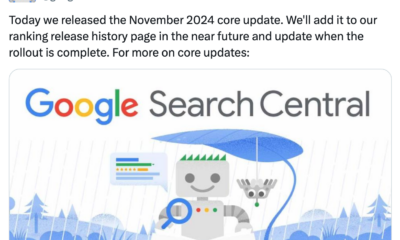SEO
8 Brands Using Twitter Effectively

Twitter has come a long way from its humble beginnings in 2006 as a 140-character microblogging site.
Today, more than 436 million people use the social media site every month to follow the news, interact with celebrities, and share information.
It was initially a platform for individuals to share thoughts, opinions, and ideas with the world. Enterprising marketing strategists soon realized it was the perfect app for engaging with consumers and initiating conversations about brands.
That’s not to say there weren’t several missteps along the way.
In the early days of social media, which was sometimes called “new media,” so-called “experts” didn’t know much more than your average early tech adopter.
Without much data to back up their strategies, they often made things up as they went along. And this sometimes had disastrous results (remember when DiGiorno coopted a trending hashtag without realizing it was about domestic abuse?)
But as is usually the case, as Twitter became a regular part of global culture, savvy marketers began to understand how to use the platform effectively.
But like no two businesses are alike, no two tweet strategies will be identical.
Let’s take a look at some brands that are top performers on Twitter and discuss what it is about them that makes them so successful.
The Fan Interaction Master
Few fanbases are as rabid as gamers.
From sharing gameplay footage to discussing the latest release rumors, video games are a consistently popular topic on social media platforms.
And in the Twitterverse, no one is more popular than PlayStation.
At the time of writing, the primary account for the Sony gaming console had 26.6 million followers. Used to promote games via trailers, advertise sales on the PlayStation store, and tease new content, nearly every post receives hundreds of retweets and thousands of likes.
And this is just one of the accounts under the PS brand.
In addition to the main account mentioned earlier, they also have a dedicated support account to help users resolve hardware issues and bugs, an account dedicated to Vita (its handheld gaming system), and different accounts for different global regions.
Working together under one umbrella, PlayStation provides remarkable brand consistency and offers everything from technical support to game recommendations.
But what separates PlayStation from lesser brands is the responsiveness with which its accounts are managed.
From resolving hardware issues and bugs to recommending games for purchase, the account is known for being approachable and seeking to help the gaming community in any way it can.
They’re not stingy with the retweets, and fans have rewarded them with engagement.
What you can learn from PlayStation’s Twitter: Social media is all about conversations. Whereas traditional media like television or outdoor are a one-way street where brands speak at their targets, Twitter allows you actually to hold a conversation. Engage with your audience for maximum results.
The Entertainer
Once known as the fast-food place with the square burgers, Wendy’s has lapped the competition through social media.
And the main reason for that is how the account is run. With 3.9 million followers, Wendy’s outperforms the bigger burger joints in interaction and engagement.
This may be because, unlike most companies, Wendy’s doesn’t play it safe on Twitter.
Looking for a way to stand out (circa 2017), it went all-in on hilarious takedowns of the competition and savage clap backs on consumers. And people love it.
In 2018, Wendy’s launched National Roast Day with its hashtag.
This social media holiday quickly became a can’t-miss event for the platform, with the fast-food brand pulling no punches and showing no mercy in short and insulting tweets aimed at competitors and customers alike.
And every year, people and companies of all types lined up for their roast, hoping to snag a little bit of Wendy’s social media clout.
What makes Wendy’s Twitter so successful? It’s the consistency, creativity, and wit with which it is run. Wendy’s has created a brand voice that is unique and authentic, adding to conversations in a humorous manner that resonates with audiences.
In an era where many brands are afraid of taking chances, lest they fall afoul of public opinion, Wendy’s is unabashedly outspoken. Their content is relevant and on-topic with current events, insulting without verging into the offensive. It’s a fine line to walk, but Wendy’s has mastered it.
What you can learn from Wendy’s Twitter: Funny will get you a long way. Your Twitter account doesn’t have to be run by an insult comedian, but developing humorous content will generate a lot more follows and shares that boring vanilla “look how great we are” or “this is our new product” posts.
The Account With Humanity
Flying is stressful. Just ask anyone who has run through a terminal to catch a connecting flight or remove their belt, shoes, and jacket, only to set off the metal detector at security.
And in this high-stress, often the uncomfortable environment, one brand manages to stand out on Twitter: JetBlue.
On an all-too-often impersonal platform, JetBlue has found a way to convey authenticity and personality while demonstrating an exceptional level of customer service.
Unafraid to tackle complicated customer service issues or address negative feedback, this account provides unexpected responsiveness from a corporation this size – or any size, for that matter.
JetBlue’s dedicated customer service team seeks to respond to every Tweet directed their way. From helping travelers change reservations to tracking down lost luggage, their Twitter account shows a remarkable amount of compassion and self-awareness.
And on top of this, the airline has a clearly defined brand persona that is warm, inviting, and above all, human.
From vacation ideas to silly puns to employee photos, JetBlue posts various original content that doesn’t feel like mechanical branding delivered by mindless marketing drones.
What you can learn from JetBlue’s Twitter: Be authentic, own up to your mistakes, and show a bit of personality. Stiff and robotic Twitter accounts are a dime a dozen and easily forgettable. Show your audience that there is a real person behind yours, and they’ll respond positively.
The Content King
If there’s one thing baseball fans love, it’s statistics.
From basic numbers like batting average to complex stats like wins above replacement, the numbers tell a story you can’t find in most other sports. And no one knows this better than Major League Baseball.
But there’s also so much more to the game than just data. There are also diving catches, clutch extra-base hits, and tense squeeze play scenarios.
So, how does a major sporting league deal with this diversity? With segmentation, of course.
MLB’s main account is chock full of numbers for the stats geeks. Infographics give baseball fans appealing visuals about things like Albert Pujols’ on-base and slugging percentages over the last ten games.
Are you looking for something with more flash? MLB utilizes the full power of GIFs with a Twitter account dedicated to them, MLBgifs.
And for the fans still upset about an umpire’s call or those who want to brush up on the nuances of the rulebook, MLBReplays gives them another look at close and controversial plays.
Major League Baseball does a wonderful job of creating and posting the type of content its fans want for a league sometimes accused of losing touch with its fanbase.
What you can learn from MLB’s Twitter: Content reigns supreme over everything else. Give your followers the kind of content that only you can deliver.
And don’t be afraid to branch out. If your content is too diverse for a single account, create another – make sure you’re dedicating the resources to make that one successful, too.
The One Who Speaks Up
A lot is going on in the world right now, and it can sometimes feel like we’ve reached an unprecedented level of polarization. And nowhere is this more evident than on Twitter.
This is partly due to the platform’s algorithm, which promotes content similar to what a person has already interacted with. The anonymity provides for trolls and other bad actors.
In this climate, it’s no surprise many brands are afraid to take a hard stance on anything. After all, changing political winds could lead to calls for a boycott ala Keurig or Chick-fil-a.
However, one brand isn’t afraid to buck this trend and stand up for its values: Ben & Jerry’s.
From working with controversial NFL quarterback Colin Kaepernick to develop a new flavor to speaking out against the gender pay gap, the Vermont-based ice cream company has demonstrated a willingness to risk social backlash in the name of its principles.
And while this strategy may cost them some sales from people who oppose them ideologically, Ben & Jerry’s places its ability to influence the world above its corporate profits.
What you can learn from Ben & Jerry’s Twitter: Don’t be a milquetoast brand. You risk alienating a portion of your target audience by taking a stand, but you also boldly display your company’s values. And this may benefit you more in the long run.
The Thought Leader
The technology Twitter-sphere is filled with all sorts of companies run by all kinds of people.
And while some do a great job at sharing their organization’s vision of the future with the world, too many are only interested in telling you about their latest product.
And then there’s General Electric. Look at its bio: “Every minute of every day, GE rises to the challenge of building a world that works.”
GE isn’t using its Twitter account to sell you lightbulbs or washing machines.
Instead, it’s being used to establish the company as an expert in the tech industry. From green energy and healthcare to the NFL draft, GE effectively explains complex concepts within the character limit.
It uses the platform to highlight GE’s commitment to innovation while simultaneously maintaining a commitment to accessibility and personality.
Much like your favorite high school science teacher, they’ve found a way to showcase their excitement about new technologies without boring you with the minute details.
What you can learn from GE’s Twitter: Own your expertise and share your passion. It comes through with unmistakable authenticity when someone is legitimately enthusiastic about a topic. And it’s contagious. Use your Twitter account to promote what it is that excites you.
The Interesting One
Do you know that one person at a party who is incredibly captivating and is surrounded by a crowd the entire time? On Twitter, that’s Forrester.
If right now, you’re saying, “Wait, who?” don’t feel bad. Forrester isn’t a major consumer brand, unlike the other brands on this list.
If your job doesn’t regularly require you to seek out business reports and analysis, there’s a good chance you may never have come across it.
But there’s a good reason it belongs on this list: Nearly every Tweet posted by this research company is packed with links to interesting and valuable information.
For example, suppose inclusivity is integral to your customer acquisition and retention strategy (and it should be). In that case, Forrester has a Tweet and related blog post on the importance of Diversity, Equity, and Inclusion (DEI) language.
Many of Forrester’s tweets include tips, statistics, or infographics that interest their target audience (primarily business professionals). It’s good at pulling out a key statistic, then linking to one of its studies after your interest is piqued.
What you can learn from Forrester’s Twitter: People love to learn. Use your Twitter account to share your knowledge. This will not only paint you as an expert but also garner interest from your target audience.
The One Who Is Unabashedly Itself
Whether or not you’re a coffee drinker, you probably have strong feelings about Starbucks.
From the controversy around the design of its holiday cups to accusations of union-busting, the Seattle-based coffee giant has been a lightning rod for controversy.
And yet, through it all, the brand has thrived, with a Twitter account with more than 11 million followers.
How has it done this? Simply by being itself.
Starbucks embraces its role on the social media platform by creatively employing different types of media.
Everything posted, from clever headlines to GIFs of the latest drink creation, shares a certain joie de vivre while maintaining a bit of the Pacific Northwest quirkiness for which the brand is known.
For such a massive corporation, Starbucks’ Twitter account does a remarkable job of coming across as friendly and approachable.
And it probably doesn’t hurt that the account is well-known for its fan interactions. It responds to mentions with a joyfulness that is often lost in the digital sphere.
The Starbucks’ social media account team is highly skilled at portraying the brand’s confidence without venturing into arrogance.
Product images tempt Twitter users scrolling through their feeds, while witty banter keeps the brand engaging.
What you can learn from Starbucks’ Twitter: Don’t be afraid to show the Twitter world what your brand is all about. Rather than seeking to conform, celebrate your differences from the competition. Project confidence and joy, and people will love interacting with you.
Find Your Own Voice
As you’ve probably already ascertained, there’s no magic bullet to Twitter success.
Each brand must determine what works best for them and its audience. And while it may take you some time to do that, it’s well worth the effort.
According to a Hootsuite study, the average Twitter user spends more than five hours per month on the site, nearly double that of Snapchat or Messenger.
That’s a lot of opportunity for exposure, especially when you consider many people use the platform to conduct brand research.
For some brands, a successful Twitter strategy may only require posting original content twice daily.
For others, it may mean round-the-clock social listening and rapid response to questions and concerns.
Your Twitter persona may be serious or silly – make sure it matches your overall brand voice. You may be informative or inquisitive. It all depends on your industry and your audience.
But one thing you may have noticed all the brands listed above have in common: They’re all authentic. None of the examples provided give you the impression that they’re putting on a façade or attempting to portray something false.
Instead, they all find ways to find or create value in their vertical while building relationships with followers. Exactly how you do, that is up to you and will probably require some experimentation.
But one thing is sure: Twitter is only increasing in popularity, and you may miss out every day. You may not use it effectively.
So, get started today. Sit down with your team for a brainstorming session, and identify your goals, values, and voice. Then develop your strategy and then get Tweeting.
More Resources:
Featured Image: George Rudy/Shutterstock











You must be logged in to post a comment Login